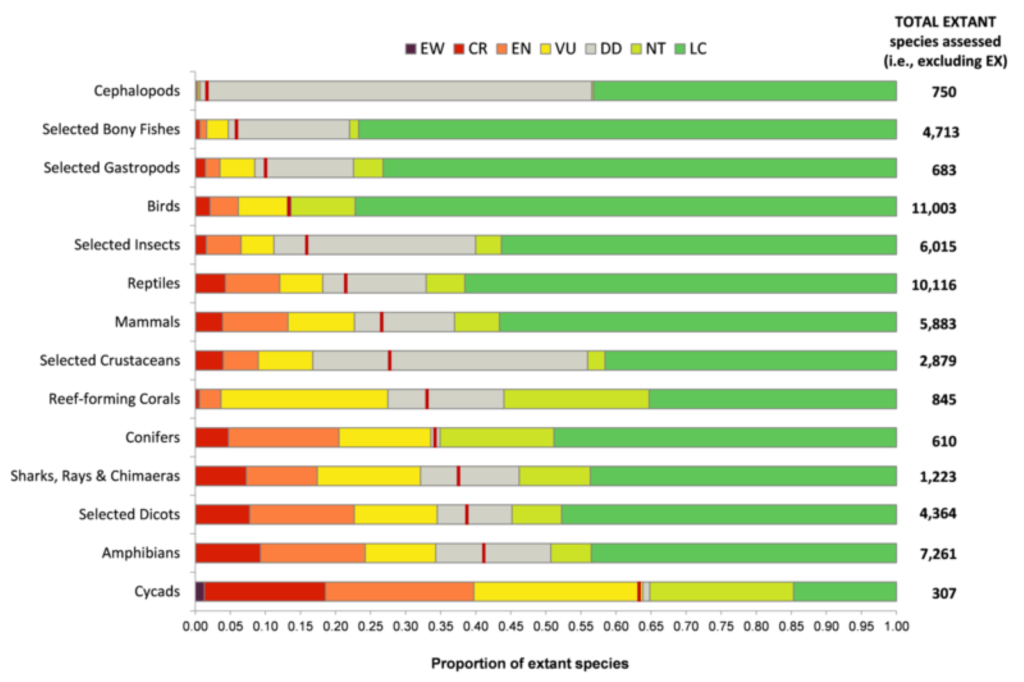WWF: Looming mass extinction could be biggest since the dinosaurs – “One million species could go extinct within the next decade, which would be the largest mass extinction event since the end of the dinosaur age”

29 December 2021 (DW) – Ever-growing environmental threats are pushing many animals and plants to the brink of extinction — the scale of which hasn’t been seen since dinosaurs died out, the German branch of the World Wildlife Fund (WWF) said on Wednesday.
The stark warnings came as WWF Germany released its “Winners and Losers of 2021,” an annual list of animals whose existence is now acutely under threat — as well as conservation victories.
Facing a mass extinction event ‘within the next decade’
There are currently 142,500 animal and plant species on the Red List of the International Union for Conservation of Nature (IUCN) — 40,000 of which are “threatened with extinction.”
It is the largest number of species to be included on the Red List since it was established in 1964, according to WWF Germany.
“Around one million species could go extinct within the next decade — which would be the largest mass extinction event since the end of the dinosaur age,” the organization said in a statement.
WWF Germany director Eberhard Brandes said decisive environmental protection policies were urgently needed, particularly in the fight against climate change.
“Species conservation is no longer just about defeating an environmental problem, but is rather about the question of whether or not humanity will eventually end up on the Red List in an endangered category — and thereby become a victim of its own lifestyle,” he said.
Polar bears and other species on thin ice in 2021
Among the animals most acutely threatened — and among the “losers” on this year’s WWF list — are the African forest elephant, whose population has declined by 86% within just 31 years.
Polar bears made the list as well, as the rapid melting of pack ice in the Arctic Ocean is making it impossible for the animals to adapt. Experts estimate the Arctic Ocean could be completely ice-free in the summer of 2035, WWF Germany said.
The familiar green faces and loud summer chirping of Germany’s tree frogs and toads are also under threat — with 50% of Germany’s native amphibian species currently listed as endangered on the national Red List. Unabated construction is limiting their habitats while roads have become death traps.
Grey cranes and migratory fish that move on land also earned a spot on the 2021 “losers” list, as well as the noble pen shell — the largest clam in the Mediterranean Sea. [more]
Looming mass extinction could be biggest ‘since the dinosaurs,’ says WWF
WWF on species extinction 2021: Cod apocalypse, mussel mortality and elephant poaching / Bright spots in lynxes, rhinos, and bearded vultures
29 December 2021 (WWF) – WWF Germany is drawing attention to some losers in the animal kingdom on behalf of thousands of endangered animal species in 2021: African forest elephants, polar bears, tree frogs, cranes, or fish species such as sturgeon and cod are getting worse and worse. Of the more than 142,500 animal and plant species included in the International Red List, more than 40,000 are in threat categories – more than ever before. In view of the new figures, the nature conservation organization WWF warns of a “catastrophic escalation of the worldwide extinction of species”. Around one million species could become extinct within the next few decades. The WWF therefore speaks of the “largest extinction of species since the end of the dinosaur era”.
But there are also bright spots in 2021, as the WWF’s annual balance sheet shows. Namely, where people work intensively on nature and species protection. One of the rarest cats in the world, the Iberian lynx, made it onto the list of winners, as did the Nepalese rhinos and birds such as Great Bustard or Bearded Vulture. A real surprise was the discovery of young animals of the Siamese crocodile in Cambodia. For the first time in over ten years, live juveniles of the extremely rare freshwater crocodiles have been sighted in a protected area.
“Species protection is no longer just about eliminating an environmental problem, but about the question of whether humanity will eventually end up on the Red List in a threat category and become the loser of its own way of life,” warns Eberhard Brandes, Managing Director of WWF Germany. “If the earth is sick, so will people. Because we depend on vital ecosystems and biodiversity for our own safe and healthy lives – for example in the fight against the climate crisis. At the same time, the winners of the list show that there are still opportunities for species protection: If we implement effective nature conservation measures, we can protect plants, animals and, ultimately, the climate.”
Losers 2021
African forest elephants: 2021 is official, what many conservationists already suspected: The African forest elephant, which lives in the rainforests of Central and West Africa, is listed on the Red List as “threatened with extinction”. Stocks collapsed by more than 86 percent within 31 years. The “gardeners of the forest” play a decisive role in forest conservation and thus in climate protection.
Sharks and rays: According to the International Red List, a third of all shark and ray species have been considered threatened since 2021. Overfishing is the main reason for the decline in stocks, but habitat loss and the climate crisis are also responsible for the precarious situation.
Polar bears: The summers of recent years have brought record temperatures over the Arctic land masses. According to a new report, climate warming in the Arctic is three times faster than the global average. In 2035, the Arctic Ocean could be completely ice-free for the first time in summer. According to studies, most polar bear populations would subsequently collapse by 2100.
Common crane: Originally, the largest bird native to Germany was distributed over large parts of Europe. Once upon a time, it would have almost become extinct in this country Due to the climate crisis, its nesting sites in Germany are now increasingly dry. The death of insects, in turn, leads to food shortages for the chicks. In 2021, too few young birds grew up in most breeding areas in Germany to secure the population in the long term.
Tree frog: The small tree frog and other amphibians are on the verge of extinction: they lose their homes due to new settlements or industrial areas. Roads and highways become death traps. According to the Red List Germany 2021, every second of the native amphibian species is endangered. Only the protection of the last retreats of these species, such as wetlands and near-natural forests, can still help here.
Noble plug shell: The largest mussel living in the Mediterranean (Pinna nobilis) can live 90 cm and up to 20 years. But in recent years, according to a recent WWF report, the occurrences in some Mediterranean regions of Spain, Italy or France have (almost) completely disappeared. The trigger of mass extinction is a parasite that spreads with warm currents. Global warming could increase this process and continue in other areas of the Mediterranean, as warm water supports the development of the parasite. Warmer water could also, it is feared, be directly harmful to the reproductive success of the mussel.
Cod, smelt and Co: For numerous fish species, which are also used by humans, things are going downhill. This led to a true cod apocalypse in the western Baltic Sea. The stock has collapsed. The tipping point, after it can no longer recover from the harmful effects of many years of overfishing and the climate crisis, has been passed. Migratory fish species that travel long distances between the sea and streams are also worse off. Salmon, sturgeon and huchen used to be widespread in our country. Due to the expansion and straightening of rivers, hydroelectric power plants, poor water quality and overfishing, the stocks of European migratory fish have collapsed by 93 percent since 1970. Due to the deepening of the Elbe, the smelt is particularly threatened.
Winners 2021
Iberian and Eurasian lynx: Comeback for one of the rarest cats in the world: A recent count showed that the population of the Iberian lynx, which is only native to Spain and Portugal, has increased more than tenfold in the past 18 years with 1,111 animals. His relative, the Eurasian lynx in Germany, is also doing better: About 130 adult animals and 59 young now live in this country. Nevertheless, the species remains dependent on strict protective measures and reintroductions.
Greater one-horned rhinoceros: For many years, WWF has been working with the government and other organizations in Nepal to protect rhinos and their habitat. The efforts now seem to have paid off. The rhino population has grown by 16 percent compared to the last estimate in 2015 and has almost doubled since the first census in 2005. In the past, the populations suffered mainly from habitat loss and the hunting of their horn.
Great Bustard in Germany: Due to intensive agriculture, the birds are extinct or acutely threatened in many countries. In 2021, however, 347 animals could be counted in Brandenburg and Saxony-Anhalt, in 1997 there were only 57 animals. Stocks in Germany are thus at their highest level in 40 years. With up to 17 kilograms, Great Bustards are among the heaviest flying birds in the world.
Siamese crocodile in Cambodia: At the beginning of September 2021, a team of researchers from the WWF and the Cambodian Ministry of the Environment made a sensational find: On a field mission, eight young animals of the endangered Siamese crocodile were discovered in eastern Cambodia. The special feature: It is the first proven reproduction in the nature of these endangered freshwater crocodiles in this region in over ten years.
Bearded Vulture: 2021 was an absolute year of success for the Bearded Vultures. In the entire Alpine region, there was an increase of 50 young vultures – including six young birds that were released into the wild. In the Alps, more than 300 bearded vultures are flying again. The international resettlement programme, which started over thirty years ago, is therefore on the right track.
Contact
- Roland Gramling, Press Spokesperson, Berlin, roland.gramling@wwf.de, Phone: 030311777425, @Roland_Gramling Twitter


